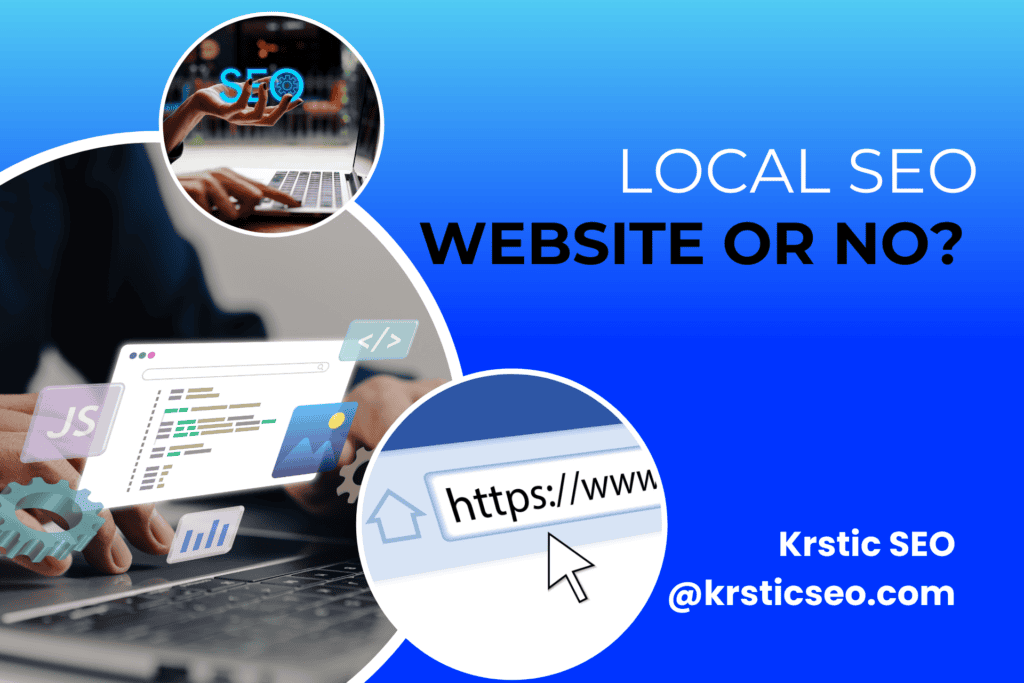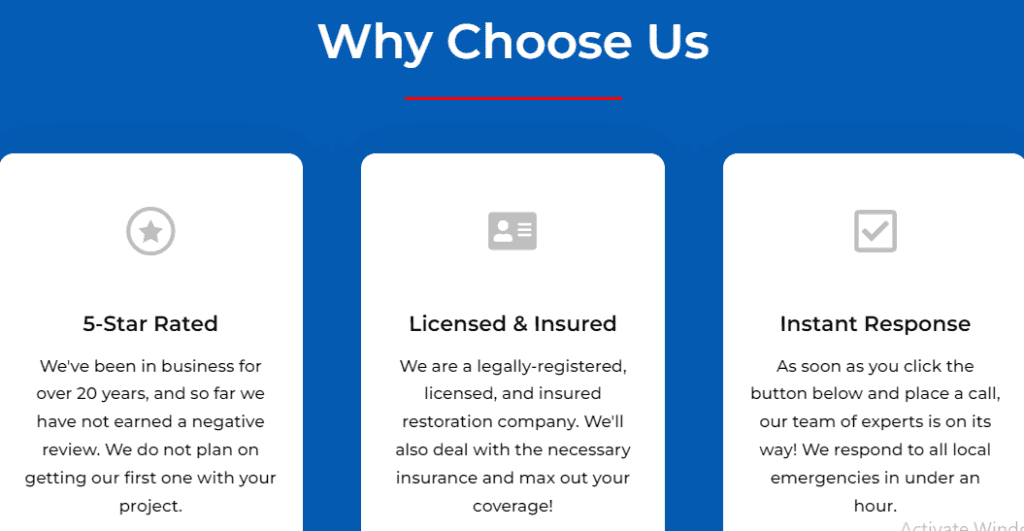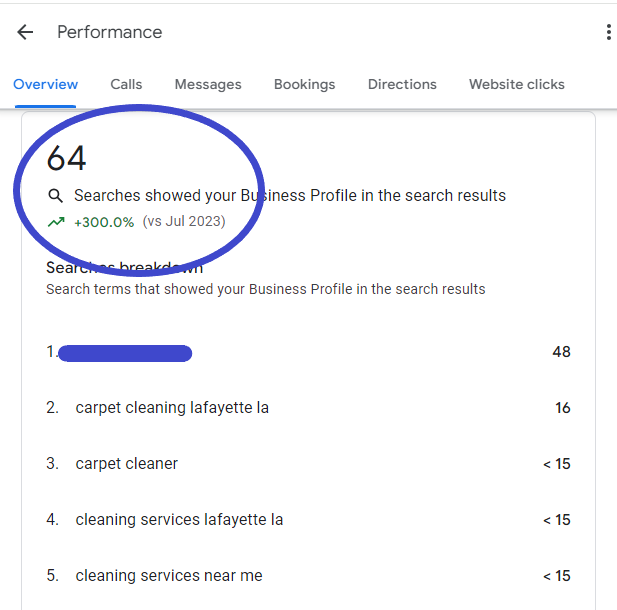In theory, yes; in reality, in most niches, no.
You indeed are able to just verify a Google Business Profile, optimize your Google Business Profile, and rank it higher on Google Maps without a website.
But to achieve the best rankings with a Google Business Profile, you, among a few other things, will need a website.
Why?
Check out the rest of the article to find out.

~6 Minute Read
Quick Answer
Google reads your website to find out what your business does. It uses that data to rank your Google Business Profile better. You'll also need a website for link building, the biggest prominence-determining factor of any business, besides *maybe* reviews.
How You Could Theoretically Do Local SEO Without a Website
Here’s a step-by-step guide on how to do local SEO without a website. It will be short, because most SEO is done to the website. Without it, there’s much less work.
Verify a Google Business Profile
This is a very simple step. Go to Google Business Profile official website and sign up.
You’ll be walked through a very simple workflow of filling out your most basic information about your business:
- Name: Make sure it’s an exact match of your business registration name
- Category: Select the correct category for your business; if you can’t find an exact match, select the closest category to your line of work
- Address: Don’t leave out a suite number if you have one
- Phone number
- Website: You’d leave this blank
- Some photos, also use videos if you have them
- And that’s it.
Depending on the category of your business, the verification method will vary. You may be asked for a simple text code, a post-card verification, or a video verification.
Follow Google’s instructions and you should be up on Maps by the end of the workweek.
Optimize Your Google Business Profile
We wrote an in-depth guide on how to optimize your Google Business Profile A-Z. Go through it, follow the instructions, and come back to this article.

Build Out Listings on Big Directories
Think of sites like:
- Yelp
- Facebook (page)
- LinkedIn (page)
- Nextdoor
- YellowPages
- Bing Maps
- Yahoo Maps
- Apple Maps
- BBB
- Any industry-specific directories
These matter because each of these sites has millions of users. They’re also individual search engines themselves, and people use them to find businesses.
Once you get approved for all of these platforms, build up your profiles through the following means.
Reviews
Besides posting regular updated photos of your newly completed jobs, you need reviews.
Review generation is a story on its own, but without a website, it’s all you’ve got. Google simply won’t rank you high without them.
Ask every single customer for a review, have them include as much details as they can to make the testimonial look great, and do that consistently.
In Which Industries Can This Work
Shorter-sales-cycle industries like the following can probably do well without a website:
- Plumbers
- Locksmiths
- HVAC contractors
And similar emergency service providers, with very short sales cycles.
Why them?
Think about it. You have a leak in your home. Will you really spend time reading 10 articles about what is going on, or will you simply go to Google, read the first three plumbers’ reviews, and then call one of them?
I’d say it’s the latter.
But this can backfire the higher ticket the service goes.
Not only will your competition most likely have their own websites (since there is a lot more money to be made), but, even though it’s an emergency, consumers may want to see more of your information, not just read a few reviews, especially if we’re talking about larger commercial jobs.

Why This Isn't The Best Approach to Local SEO
And there you have it—your no-website local SEO guide.
Now, the reasons why we wouldn’t recommend this approach are simple, and they consist of a few answers.
Lack of Consumer Trust
Around a third of consumers won’t spend money with a business without a website, whereas half of all consumers say a website is the biggest trust factor of a business for them.
That’s half of your potential customer base.
I think you wouldn’t want to just miss out on 30%-50% of ALL of your potential customers, would you?
You Could Rank So Much Better With a Website
Why?
Google "Reads" Your Website
Once Google reads your website, if it’s properly SEO-ed, you can have BOTH your website AND your Google Business Profile rank higher.
There isn’t that much information you can include in your Google Business Profile.
Think about it. You have:
- Description
- Services
- Products (for which you may not be eligible)
- FAQs
- Posts
- Photos (which isn’t even for text but for media)
And that’s it. After you do all of these one time, consistent reviews, posts, and media take over. Not much else to do.
But with your website, you can go as deep as you want, and Google will use that data for your Google Business Profile too.
Then, you will be displayed for more searches more times than before and see results like this:

This was a client’s result after launching a website. We didn’t gain many reviews or make any serious changes to the Google Business Profile in the meantime. This result was because of a better website with more information.
Website Has No Limitations
With your Google Business Profile, you’re limited to reaching consumers 4 to 10 miles away from your address.
But, with a website, you could reach way more consumers in more cities looking for a lot more services and answers to their questions.
Possible returns are infinite, and you could simply build up your website as you grow with more information about your new locations, whereas, every time you start a new Google Business Profile, you start all over again, as there’s nothing to tie up those entities as a part of the same brand besides the name.
Not to say that can’t work, but you’re off to a much better start with each new location if you have a website already built up with prominence from existing locations. Bringing us to…
Website Can Be Used for Backlinks
Backlinks determine the “popularity” of a given business on the web, and subsequently that business will rank higher the more backlinks it has.
Although there’s a lot more to backlinks than this. Check out our guide on backlinks for local SEO.
In short, with only a Google Business Profile, you can’t build good backlinks. We don’t recommend building backlinks to your Google Business Profile link directly because you don’t own the asset; Google does.
This brings us to the last point, perhaps even the biggest one.
You Own The Asset, Not Google
Besides an email list, a website could be considered an only asset a business truly owns.
- The domain, as long as you don’t let it expire, belongs to your business.
- The files you use to build your website are yours as long as you don’t delete or lose them.
- You do indeed host your website on other people’s servers, but you could also technically own your servers as well. However, nobody does that, I know.
But our main point is that you DON’T own your Facebook page, your Google Business Profile, or even your YouTube channel.
You’re at the mercy of those platforms’ increasingly unstable algorithms, with Google Business Profile suspensions (which DIRECTLY lead to loss of revenue for many businesses that rely on their profiles) being the norm these days.
Your website is not an expense; it’s an asset, and as long as you treat it like that, it will bring you leads. Maybe not today, but in the very near future if you do your local SEO right.
What to Do From Here
You most likely don’t have a website currently; hence, you’re reading this article.
Well, instead of DIY-ing your website design and SEO, which can hurt you in the long run if you do it wrong, let us do it right from the start.
First, go to our free SEO audit page and order a free market research report.
Explain that you’ve read this guide and that you don’t have a website but you’d like one made, and we’ll provide you with a video explainer of how many leads you can get and how fast that can happen.
And then, we’ll get going from there. See ya!
Learn more:

Bogdan is a local SEO expert with over 3 years of experience helping businesses grow using Google. When he is not helping businesses grow, he works on his own SEO projects, works out, takes long walks, and watches Suits, which is completely ironic given how rarely he dresses up in a suit himself.
